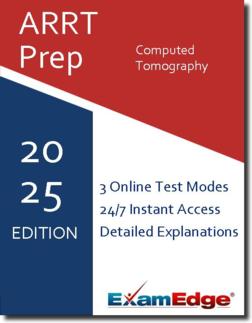ARRT® Computed Tomography (CT) Practice Tests & Test Prep by Exam Edge - Test Reviews
Based on 32 Reviews
- Real Exam Simulation: Timed questions and matching content build comfort for your ARRT Computed Tomography test day.
- Instant, 24/7 Access: Web-based ARRT Computed Tomography practice exams with no software needed.
- Clear Explanations: Step-by-step answers and explanations for your ARRT exam to strengthen understanding.
- Boosted Confidence: Reduces anxiety and improves test-taking skills to ace your ARRT Computed Tomography (CT).

ARRT® Computed Tomography (CT) Practice Tests & Test Prep by Exam Edge - Review
ARRT Computed Tomography - Reviews
Excellent
Based on
160
reviews
“ Hi, I just wanted to say thank you ! The tests really helped me prepare for the advanced level MRI ARRT Registry exam.
Anthony , California
“ Thank you! I had tried to pass this exam before I found your site and was never able to do it. After your practice exams, I was able to pass on the next attempt!
Jane, PA
“ Thank you for being a great tool site for my VI certification exam. It helped me prepare for "battle". Practice makes perfect, alright.
Noel , NY
“ Sorry, but it didn't help me.
MARIA , Austin, Texas
“ Great practice for taking the MRI registry..the test gave me a baseline on the knowledge I have and the knowledge I need to study more on before taking the exam. It helped with the verbiage used for the questions.
DEBORA , Allen, Texas
“ Like MRI in Practice.
keith , Silver Spring , MD
See why our users from 154 countries love us for their exam prep! Including 32 reviews for the ARRT Computed Tomography exam.
Exam Edge is an Industry Leader in Online Test Prep. We work with our Institutional Partners to offer a wide array of practice tests that will help you prepare for your big exam. No Matter how niche field of interest might be, were here to help you prepare for your test day.
| 2.8M | 4.5M | |
| Users | Tests Taken | |
| 100K | 19 | |
| Unique Exams | Years in Business | |


